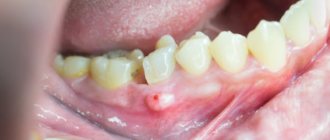Treating gumboil with soda and salt is an effective way to prevent and eliminate unpleasant oral diseases. But before you use it, you need to know the cause of gumboil, what it is, and also be sure to visit an experienced dentist who will first carry out the necessary treatment. After all, soda and salt cannot get rid of already accumulated pus.
Types of flux
This pathology is characterized by several stages of its clinical development. At the first stage, minor pain appears. The second stage is characterized by swelling and redness of the gums in the area of infection.
During the third stage, pus appears, the temperature rises, and the cheek and gum area swell noticeably. At the fourth stage, a person feels a sharp throbbing pain, swelling intensifies, and an extensive inflammatory process may begin. The following types of flux exist:
- Ordinary.
The pathological process occurs without infiltration of the periosteum by pus;
- Fibrous.
With this type of periostitis, inflammation spreads to the periosteum tissue;
- Orthodogenic periostitis.
The disease manifests itself in the form of osteomyelitis, which is a serious complication requiring surgical tooth extraction;
- Albuminous flux.
Chronic pathology, which is characterized by a sluggish course, subfertile temperature and suppuration.
Only a dentist can determine the type of disease and prescribe proper treatment, but before visiting, it is necessary to stop the process.
Recommendations after opening the flux
When the first symptoms of flux development appear, you should not self-medicate. It is a mistake to believe that swelling and pain can be relieved with warm compresses, lotions based on herbal infusions or other folk remedies. Independent experiments aimed at combating flux can lead to complications.
It is important to remember that you should not take painkillers less than 3 hours before visiting the dentist. Otherwise, there will be problems with making a diagnosis. After the tooth flux has been exposed, you should not take aspirin, as it increases the risk of bleeding. If after 12 hours the condition has not improved, you should consult a doctor immediately.
Rinse with flux
Rinse solutions have a regenerating and anti-inflammatory effect on the pathological focus. You can use a soda solution, which reduces pain and inflammation. Rinsing should be done every two hours. Two teaspoons of soda are dissolved in 200 ml of warm water and used throughout the day.
Manganese solution has good therapeutic efficacy. It will reduce swelling by eliminating pathogenic microorganisms. You can use the drug Rotokan, which includes chamomile, yarrow and calendula. To prepare the solution, just add one spoon of Rotokan to warm water. You should rinse your mouth at least 4-5 times a day.
Antiseptics such as Chlorhexedine and Miramistin are also used. They do not need to be dissolved in water. It is enough to irrigate the affected cavity in order to reduce swelling, pain and inflammation. Rinse products similar in their therapeutic effects to Miramistin and Chlorhexidine also include Furacilin, which is sold in tablets. A couple of tablets are enough to prepare 200 ml of solution for treating the oral cavity.
Anti-inflammatory pills
Anti-inflammatory drugs for flux have a strong analgesic effect, relieve swelling and reduce inflammation. Some of the medications used can relieve high fever, which sometimes accompanies the symptoms of periostitis.
Nimesil
Flux tablets with a pronounced analgesic effect actively eliminate inflammation at all stages of the disease. The daily dose of the drug is 200 mg (1 tablet of 100 mg twice a day). The duration of treatment depends on the clinical picture of periostitis and the need for treatment of toothache.
Diazolin
A drug for flux from the group of antiallergic drugs. It has a strong anti-edematous effect, reduces the production of biologically active inflammatory substances at the site of abscess development. Diazolin is taken depending on the severity of swelling of the gum and cheek tissues, 1 tablet (100 mg) 1-3 times a day until the condition improves.
Diclofenac
An anti-inflammatory drug that has a powerful anti-inflammatory effect, significantly reduces toothache. To eliminate pain, use 25-50 mg 1-2 times a day.
Compresses and lotions for periostitis
Compresses and lotions have a local anti-inflammatory and disinfecting effect, they destroy pathogenic microbes and will help get rid of swelling on the mucous membrane. You can use the drug Dimexide, which is diluted with water until a concentration of 20-30% is reached. The compress is applied to the area of inflammation and left for about an hour.
Soda lotions also help a lot. Baking soda is diluted in a volume of two teaspoons in 200 ml of water. You can moisten a cotton pad or several layers of gauze with the solution and then apply the lotion to the affected area of the gum.
Good therapeutic effectiveness is also observed when using salt compresses. It is enough to dissolve a couple of teaspoons in 100 ml of warm water. A gauze swab soaked in the solution should be applied to the inflamed area and held between the gum and cheek for at least half an hour.
Prevention
Understanding what gumboil is, you need to monitor the condition of your teeth and gums. Prevention consists of following hygienic rules for caring for the oral cavity. It is important to buy a quality toothbrush and good toothpaste to minimize the risks of developing caries. You need to brush your teeth twice a day: morning and evening.
After eating, it is necessary to remove food debris from the interdental spaces and use a mouth rinse to treat the oral cavity. To do this, you can buy the product at the pharmacy or prepare it based on propolis tincture, sea or table salt.
It is important to visit the dentist twice a year for preventive examinations. All diseases at the initial stage are successfully treated. Tartar should be removed regularly. It is in these deposits that pathogenic bacteria multiply, which, if the soft gum tissue is accidentally injured, can cause the development of gumboil.
To strengthen your gums, you must include fresh fruits and vegetables in your daily diet: apples, carrots, etc. They clean plaque on tooth enamel, which reduces the likelihood of tartar formation.
Anti-inflammatory drugs and antibiotics
The use of antibiotics helps relieve pain and stop acute inflammation. You can use antibiotics such as Trichopolum, Lincomycin, Ciprofloxacin, Flemoxin, Biseptol, Amoxiclav, Tsiprolet. Antibacterial drugs should not be used for more than five days to avoid microbial resistance in the body.
To reduce swelling and redness, you can additionally take Diazolin, Nimesil or Diclofenac, which have a local anti-inflammatory and decongestant effect.
How to treat flux in a child?
Quite often, parents ignore the fact that they have baby teeth affected by caries, reassuring themselves that permanent teeth will soon grow in their place. However, an infected gum can cause gumboil to develop. The child’s body does not always react to periostitis with an elevated temperature, and the only symptom may be minor pain, which is not given any importance. The immunity of children is weaker than that of adults, so the disease progresses quickly.
In order to prevent complications, it is necessary to begin treatment at the first sign - clean the canal, close the hole in the tooth with a filling.
Gels and ointments
Ointments are used for topical application. In particular, this is Vishnevsky’s ointment, which stops the development of the purulent process. The birch tar included in its composition increases blood circulation in tissues and accelerates their natural regeneration.
Among modern gels, it is recommended to use the drug Metrogyl Denta, which contains antibacterial components in the form of Chlorhexidine and Metronidazole.
This article is for informational purposes only, please consult your doctor for details! Ask your doctor about contraindications and side effects.
Flux - treatment in a dental clinic
The choice of treatment method for flux depends on the type of periostitis, its severity, and the individual characteristics of the body. In the acute form, the nerve is removed, the wound is opened and cleaned, treated with antiseptics, and antibiotics are prescribed.
To defeat purulent flux in an adult, they resort to a more comprehensive treatment program. In this case, additional procedures may be prescribed, as well as complex antibiotic therapy.
Regardless of the type of periostitis (excluding the chronic form of flux), a mandatory step is a course of antibiotics, which is selected individually. As a rule, with the right course of treatment, the flux goes away within 7-10 days (stable positive dynamics of recovery are recorded on days 3-5). In the chronic course of the disease, the tooth after gumboil is usually removed.
Let us remind you once again that by refusing professional help, you risk your health. Without the participation of a doctor, there is a high probability of the formation of a gingival fistula, the penetration of pus into nearby tissues, which causes the development of phlegmon.
Why is periostitis dangerous and how to avoid it?
The causes of the disease do not appear overnight, but accumulate in the body over several months or years. Therefore, it is very simple to resist the appearance of tooth flux in an adult:
- Get a routine dental checkup every 6 months. This way you can identify pathologies and anomalies of the oral cavity in the bud and, using simple procedures, prevent their transformation into gumboil.
- Use professional oral hygiene services once every six months. Tartar and hard plaque cannot be removed at home, but they become the cause of many oral diseases.
- Consume more vegetables and fruits. They supply the body with useful substances, and also perform mechanical cleaning of the teeth and interdental spaces during the chewing process.
Possible complications of periostitis in the absence of treatment: sepsis, meningitis, abscess, phlegmon, osteomyelitis and others, up to and including admission to the department of maxillofacial surgery.
Any disease, including gum gum disease, is easier to prevent than to treat. If the inflammatory process has begun, do not rely on traditional methods and self-treatment. The purulent formation will not disappear on its own; only high-quality medical intervention will help eliminate the inflammation and avoid serious consequences.
What EliteDental M dentists recommend
It happens that the patient does not have the opportunity to see a doctor immediately (harmful management at work, urgent matters or meetings, no one to leave the child with, etc.). Therefore, our dentists have put together a number of tips for you to slow down the development of gumboil and relieve primary swelling.
The tips have been tested in practice by our patients and help well as first aid. They work great to prevent the appearance of flux. And yet, you shouldn’t completely forget about visiting the dentist. How to deal with the appearance of flux yourself:
- Rinsing. The most effective is the old-fashioned method of rinsing your mouth with a solution of soda and salt. This will help reduce the number of germs in your mouth, but will not get rid of gumboil. Rinsing has only an external effect. No solution will reach the infection inside the gum.
- Painkillers. When the situation is not reversible, severe pain occurs (gums, headache). You can take your usual painkillers.
- Do not self-medicate. Treatment with folk remedies either helps or worsens the situation. In practice, there have been cases where self-medication led to emergency surgery. Don't guess whether it will pass this time or not. It’s better to make an appointment with your dentist once again. This will save your teeth, money and nerve cells.
Be attentive to your health! Make an appointment with the dentist by leaving a request by mail or by phone +7 (988) 544-63-54 (Zhdanova St. 3), (Mironov St. 6).
FAQ:
How to rinse the flux to make it break out?
As we wrote above, any procedures cannot replace consultation and treatment in a dental clinic. Before visiting a doctor, in order to alleviate the condition and reduce swelling (edema), you can rinse your mouth with various antiseptic and antimicrobial agents, for example, chlorhexidine. Additionally, you can use sodium saline solution, sage decoction, and calendula tincture.
The flux has burst - what to do?
If the flux has burst, the time before visiting the doctor can be used to carry out simple procedures on your own. First of all, you should rinse your mouth with clean water at room temperature. You can do this using a soda solution - to do this, you need to dissolve a teaspoon of soda in a glass of warm clean water. It is advisable not to eat before being examined by a doctor.
What to do to prevent flux?
The best prevention of flux is regular hygiene procedures in the oral cavity and timely treatment of foci of chronic infection.
Do not forget that gumboil may not go away on its own, turning into a chronic disease, and given that it poses a serious danger to human health, we recommend that you do not hesitate to contact a dental clinic. Only here is reliable diagnosis and effective treatment possible. Be healthy!
Treatment methods
In folk medicine, there is an opinion that a lump on the gum, i.e. flux, needs to be treated with hot compresses. However, this is strictly prohibited, especially in the presence of purulent inflammation, since when heated, the pus very quickly spreads along with the bloodstream throughout the body, which is fraught with inflammation of absolutely any organs, incl. brain. When treating flux, it is necessary to open the lump and install drainage for the outflow of pus, and prescribe drug therapy. The entire process of complete rehabilitation may take several weeks.
Opening a purulent abscess Treatment of flux is carried out as follows: a small incision is made on the gum, where drainage is installed - a thin tube that connects the oral cavity and the purulent focus. An outflow of pus occurs through it for some time, and at the same time a course of antibiotic therapy is prescribed. Canal treatment is also carried out, and after complete healing, the shape and functionality of the tooth is restored.
Price:
4000 rubles more details about the solution
Treatment of dental canals Periostitis, as a rule, occurs due to the presence of inflammation inside the tooth or in the periodontal tissues. Therefore, root canal treatment may be required for complete rehabilitation. To do this, the cavity is opened, thoroughly cleaned of inflammation, and if necessary, a drug is placed inside the root system to affect the periodontal tissues, i.e. to the site of inflammation. After which the canals are filled and the coronal part is restored.
Price:
from 4,500 rubles more about the solution
Tooth extraction Extraction may be required in the presence of an advanced disease, when neither opening the abscess nor drug therapy will help to fully restore the tissue and save the tooth. It is removed, the hole is thoroughly sanitized and the purulent focus is removed. At the same time, medications are prescribed to reduce the inflammatory process and quickly rehabilitate the body.
Price:
from 1500 rubles more about the solution
Symptoms of the disease
Signs of pathology largely depend on the individual characteristics of the patient’s body, however, there are general symptoms that indicate the appearance of gumboil:
- a lump on the mucous membrane, which has different sizes - up to several cm in diameter and even in height,
- formation of an abscess and fistula if there is purulent inflammation,
- sharp pain that can radiate to the ear, eyes or temples,
- swelling of the gums and parts of the face,
- enlarged lymph nodes in the neck and under the jaw,
- fever up to 38 degrees, general weakness and poor health.
In some cases, a fistula opening appears on the abscess itself, through which purulent masses will enter the oral cavity. In this case, the pain becomes less pronounced, the patient’s condition improves, because there is an outflow of pus and a decrease in the inflammatory process. However, this does not mean at all that a complete cure has occurred - the pus will not be able to come out completely on its own. Drug therapy and surgical intervention are still required, i.e. specialist help.











